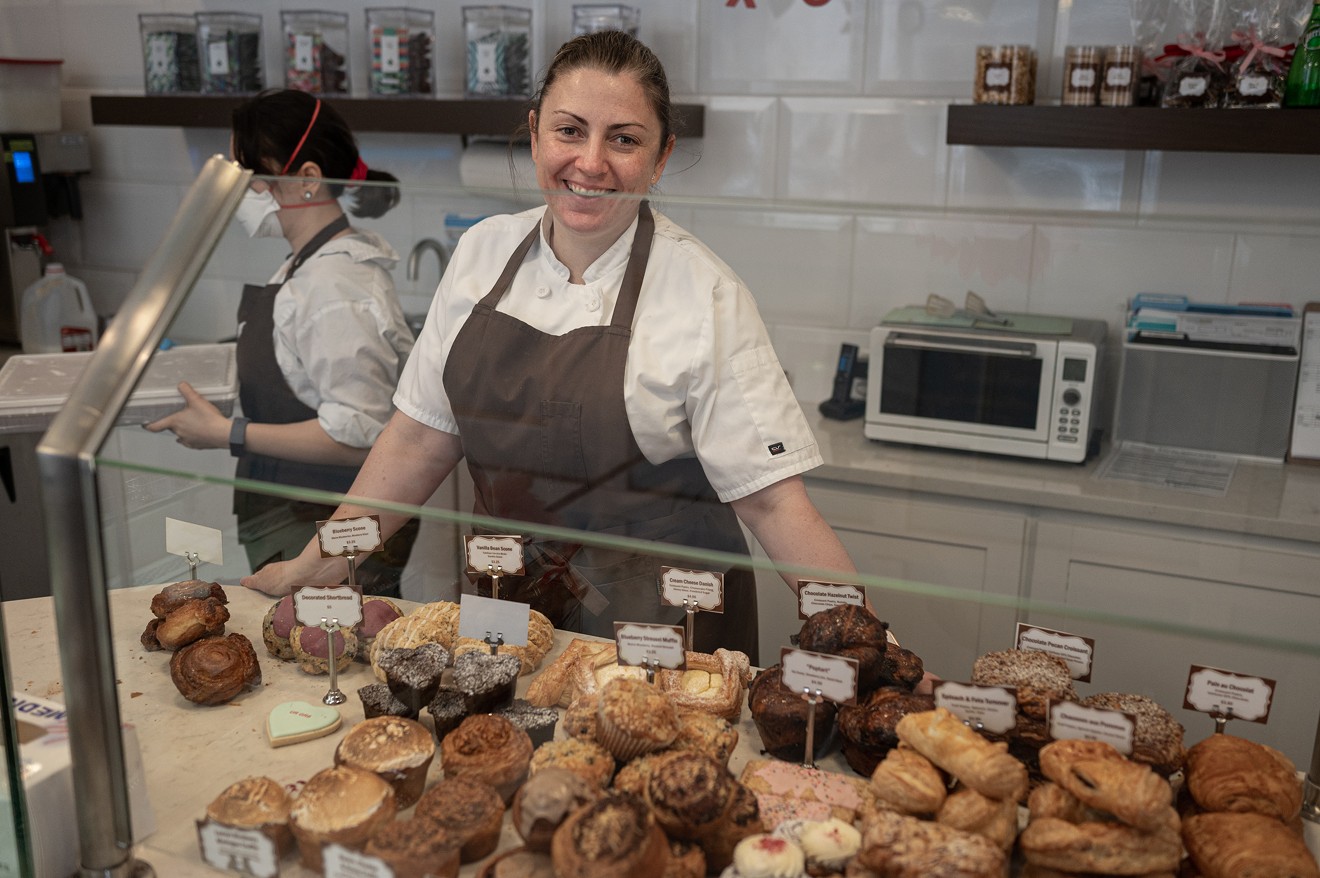It’s definitely not the romantic scene one might envision when they think of owning a quaint French bakery. There are no sexy scenes a la Chocolat or dramatic Paul Hollywood handshakes with those stealth blue eyes.
“It’s all about logistics,” chef and owner Andrea Meyer says. Getting products just in time to get them out, all on a tight schedule, with cases full of perfect pastries on display every morning.
On a Wednesday afternoon with Valentine’s Day approaching, Meyer was searching her kitchen for round plastic trays to hold stacks of bright macaroons, which are usually big sellers in mid-February. She has a stack of cellophane lids, but no trays.
“I normally would promote little macaroon platters, and it [Valentine’s Day] is on a Monday this year, so how cute would that be to take these into the office?” Meyer says, “But I can’t find any trays and AceMart said the place that makes them literally went out of business. So they’re trying to source them somewhere else.”
The past two years probably haven’t been great for people who make trays for office parties, and they certainly haven’t been kind to small restaurants and bakeries. Labor shortages have led to wage increases. Shipping quagmires have snarled deliveries and inventories, driving up prices. Waves of COVID variants have slowed production. "Transitory" inflation is parked on our shores and isn’t moving.
Not far from the stack of bottomless cellophane lids at Bisous Bisous is a stack of butter. There are piles of butter everywhere. Every station in this kitchen has pounds and pounds of butter on standby, waiting to be coaxed into something beautiful and decadent.
Butter is the big kahuna of the baking business. It’s key to good pastry, and the price of butter is up more than 100% from a year ago. When you push out more than 400 croissants a week, that hurts.
In January 2021, the average price of butter was $1.35 per pound. The average price this past January was $2.72; a 101% increase. The U.S. Department of Agriculture said in a January report output is “hampered at some facilities due to labor issues and delayed production supply deliveries.” Bulk butter inventories are tight and some “end users report paying hefty premiums to secure spot loads.”
Plugra is a European-style butter preferred by most pastry chefs because of its higher fat content and lower moisture that creates flakier pastries. Kuluntu Bakery is a cottage business in Oak Cliff that bakes sourdough bread and pastries. They recently posted on their Instagram account they’ve had to raise their prices because Plugra has increased $27 a case since December 2021 and $36 since September 2021.
“It’s gotta be double digits,” Meyer says when asked about the overall increase in doing business now compared to before the pandemic. “We’re not talking about a mild increase. Just the basics — butter, sugar, eggs, flour, stuff that we use massively fast — it’s gone between 35 and 60% higher if not double the price.”
“I had to raise my wholesale prices,” Meyer says. “And retail prices are going to go up too, I just want to sharpen my pencil as much as I can and not appear that I’m gouging anybody. Literally every single thing costs more. From plastic wrap to parchment paper to almond milk. Everything.”
But it’s not just the baking business. It’s every business. Our local restaurants, bakers, brewers and pitmasters are all being hit with higher costs while riding this out. Is it even a ride? Or is it the new normal?
**

Pitmaster Rene Ramirez had to increase the price of a meat plate at 225 BBQ to make ends meet.
Mike Brooks
Now, Ramirez starts most mornings around 2 a.m. He just sleeps at his trailer on mornings he has to cook. His first task is to heat his pit. He stacks post oak in the offset smoker. Around 4 a.m., he starts loading up briskets, placing about a dozen slabs of meat at different spots inside the pit.
Around 6 a.m., when the stores start opening, he heads off in his truck to buy fresh produce and supplies for the day: limes, tortillas, cheese.
“Everything has gone up,” Ramirez says. Increases across the board eat into his slim margins, from gas to the price of brisket, which has almost doubled in price since the day he quit his day job. His latest invoice came in at $5.09 a pound.
“In 2020, our one meat plate was $14. Now, it’s $17 just so we can make some profit,” Ramirez says.
Are customers noticing these slight price hikes? You bet.
Black Box Intelligence tracks online comments concerning restaurants. Early this year, they found that there were fewer positive mentions of “specials” at full-service restaurants. Plus, there were more negative mentions of the restaurant experience, including “not worth it.” In casual dining spots, there were also fewer positive mentions of “reasonable prices.”
Coupled with that, diners are mentioning restaurants being short staffed at a record clip. Black Box found the last couple of weeks of December “(...), there were steep weekly increases in mentions of 'short-staffed.'”
The publication Restaurant Business noted that “menu price inflation hit a 39-year high in November as soaring costs for labor and food led restaurants around the country to increase their charges to customers.” They point mostly to a labor shortage that has led to wage increases as the culprit.
Meyer says she’s paying higher wages for everyone across the board. “After the pandemic, it wasn’t even a question," she says. "You have to pay at least $15 an hour now except for possibly an intern, but even then.”
As much as restaurants have endured the past two years, particularly independently owned restaurants, how much more can their businesses take?
Dean Stansel, an economist at SMU Cox's Bridwell Institute for Economic Freedom, says some of those costs can be passed along to their customers in the form of higher prices, “but there are limits to how much more consumers are willing to pay. This has been particularly problematic for small businesses like restaurants because they lack the ability to get the same volume discounts on their inputs that larger businesses can.”
Which has long been a rallying cry in local social media posts and various outlets. Chipotle can endure the hikes. But if you want your local restaurants to stay around, they need your business now, higher prices or not.
For both Meyer and Ramirez, it’s a thin line between turning customers away and making money. Some decisions make themselves. When the cost of pistachio paste went from $55 to $178, Meyer took her green-swirled pistachio croissants off the menu. But when a tight labor market demanded $15 an hour for employees, she adjusted. Even her workhorse — the humble blueberry muffin — is causing headaches. The price of blueberries has gone from $28 a case to $53. She’s spent time carefully poring over ingredients and menus to see where she can trim costs: what pastries to keep and which to let go.
“This was going to be the year I was going to pay myself,” Meyer says.
Stansel, who points at expansionary monetary policy at the federal level as part of the problem, doesn’t offer a rosy outlook. “The pandemic has forced many small businesses, like some of our favorite restaurants, to shut down entirely,” he says. "Some of those that have remained open are barely covering their costs. If the increased inflation continues, those rising costs may be the final nail in the coffin for some small business owners.”
**
Wim Bens is co-owner of Lakewood Brewing Co., which opened in 2011, one of the first craft beers on the local brewing scene. At first, selling kegs and hosting tastings at the brewery was the goal. More than a decade later, they’ve taken their little brewery far; cans of their lager and Temptress line the shelves of grocery stores and are commonly found at bars and restaurants across North Texas. Overall, Bens say they use more than one million cans a year, which is about five truckloads packed with 200,000 cans.
When bars and restaurants shut down early in the pandemic, breweries and soda drink manufacturers moved their inventory from kegs and spouts to cans. This created a shortage of aluminum, which sent the price soaring. Things got so tight at one point Bens bought cans from a discontinued line and slapped his labels over theirs.
When Stansel talks about the small places getting hurt the most, craft breweries are a perfect example; it doesn’t take an economist to figure out who gets a better deal on tight inventories between Miller Lite or Lakewood Brewing. Bens says the cost of his cans is up 70 to 100%.
The Financial Times reported on Feb. 9 that in addition to increased demand and tight supplies for lightweight metal, tensions in Ukraine have pushed prices even higher. In bigger news, because of electric vehicles and some other factors, inventories are being quickly depleted.
What’s next?
“I don’t know. I really don’t. I feel like we’re just managing it as it comes right now,” says Meyer. “I’ve just really started looking at the retail prices lately, instead of just meddling in the prices. We need like a whole redo. At least to have a better understanding of like … the blueberry muffins, I used to know that was my standby, but now I’m not sure. What else is it going to be? What can it be?”
She points out that chefs are built for adversity. “We’re used to stuff flying at our heads all the time. Like this order now, this is on the fly, now this. There’s no ‘Oh, it’s Friday, I’m going to go home, and I’ll work on this on Monday.’ No, I have to do this now because the customer is waiting for me. There’s such a sense of urgency. This level of having to problem solve is inherent in our personality. This now is tackle-able, but I don't feel like we’re getting ahead of it.”













